
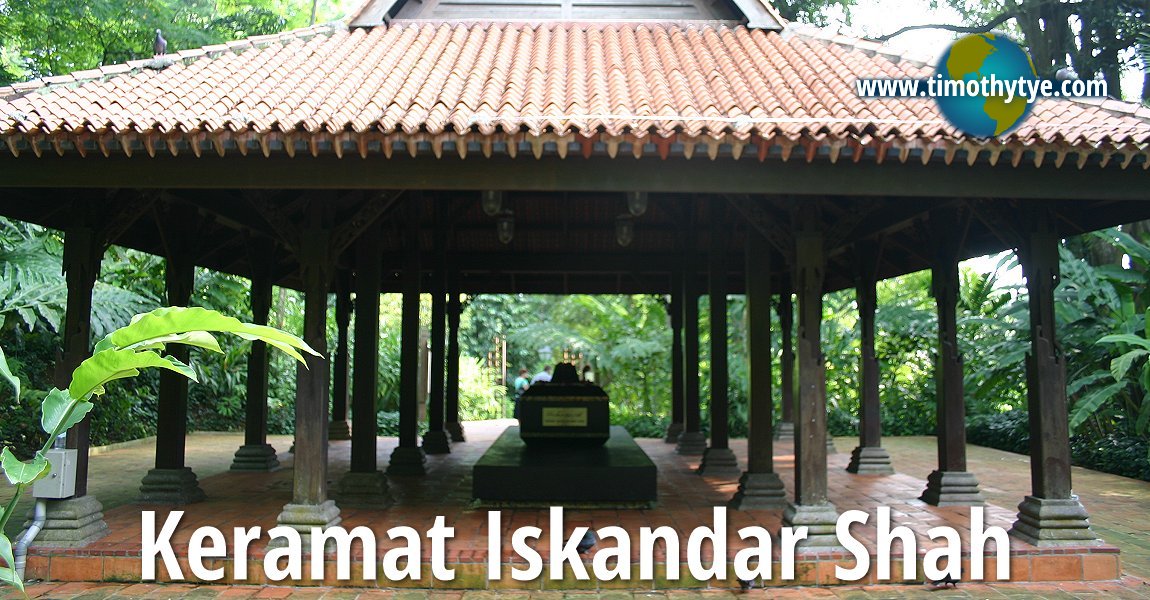 Keramat Iskandar Syah, Singapore (9 July 2006)
Keramat Iskandar Syah, Singapore (9 July 2006)
Keramat Iskandar Syah
 (GPS: 1.29436, 103.84728), or the Shrine of Iskandar Shah, is believed by some locals in Singapore to be the burial site of Raja Iskandar Shah, the last of five kings to rule Singapore in the 14th century. Some scholars and historians have matched him as Parameswara, the founder of the Sultanate of Malacca, although more research is being presently under study.
(GPS: 1.29436, 103.84728), or the Shrine of Iskandar Shah, is believed by some locals in Singapore to be the burial site of Raja Iskandar Shah, the last of five kings to rule Singapore in the 14th century. Some scholars and historians have matched him as Parameswara, the founder of the Sultanate of Malacca, although more research is being presently under study.Since 1822, this site has been regarded as the keramat and makam or tomb of Raja Iskandar Syah. According to Malay traditions, the first Malay king and his chief minister were buried on Fort Canning Hill. According to the interpretation board, Iskandar Syah is the last of five kings to rule Singapore in the 14th century. When Singapore was attacked, Iskandar Syah is said to have escape and moved north, where he subsequently established Malacca. Chinese chronicles recorded the demise of Iskandar Syah in 1420, but did not state the location of his burial place.
When the British cleared the land at Fort Canning Hill, they discovered ruins on this site. Archaeologists have also discovered pottery and other artifacts dating to the 14th century in the vicinity.
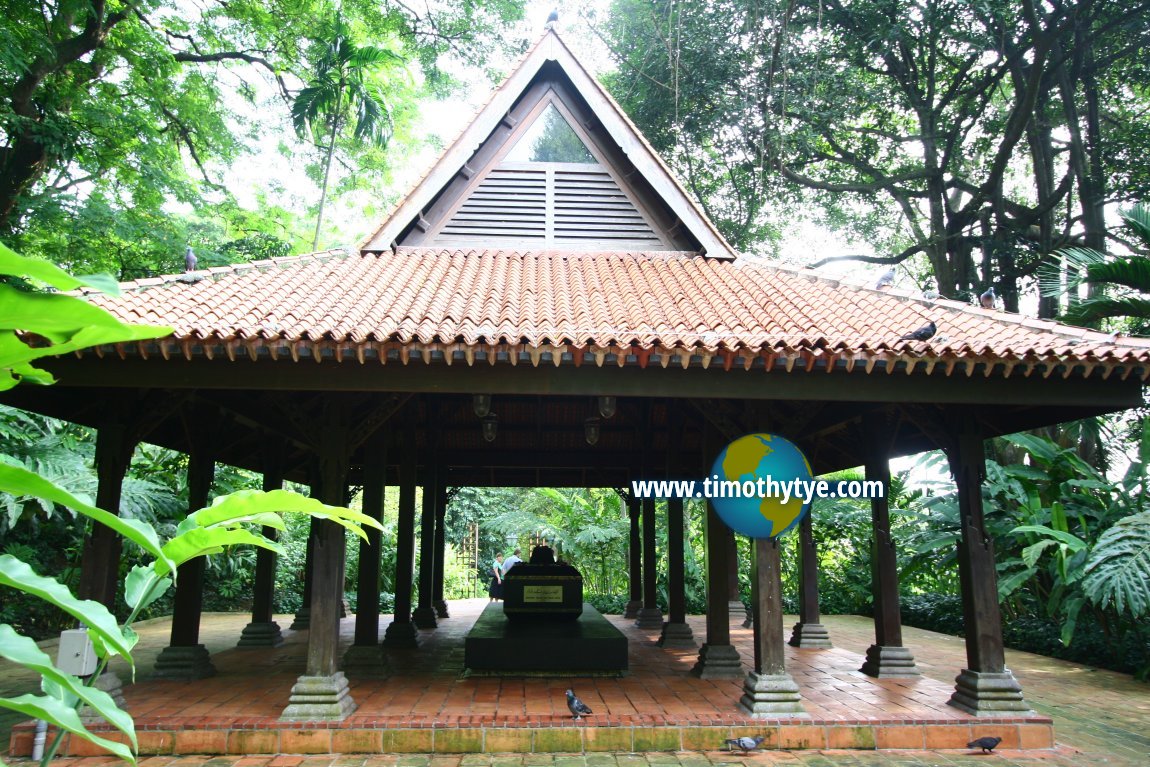 Keramat Iskandar Syah, Singapore (9 July 2006)
Keramat Iskandar Syah, Singapore (9 July 2006)
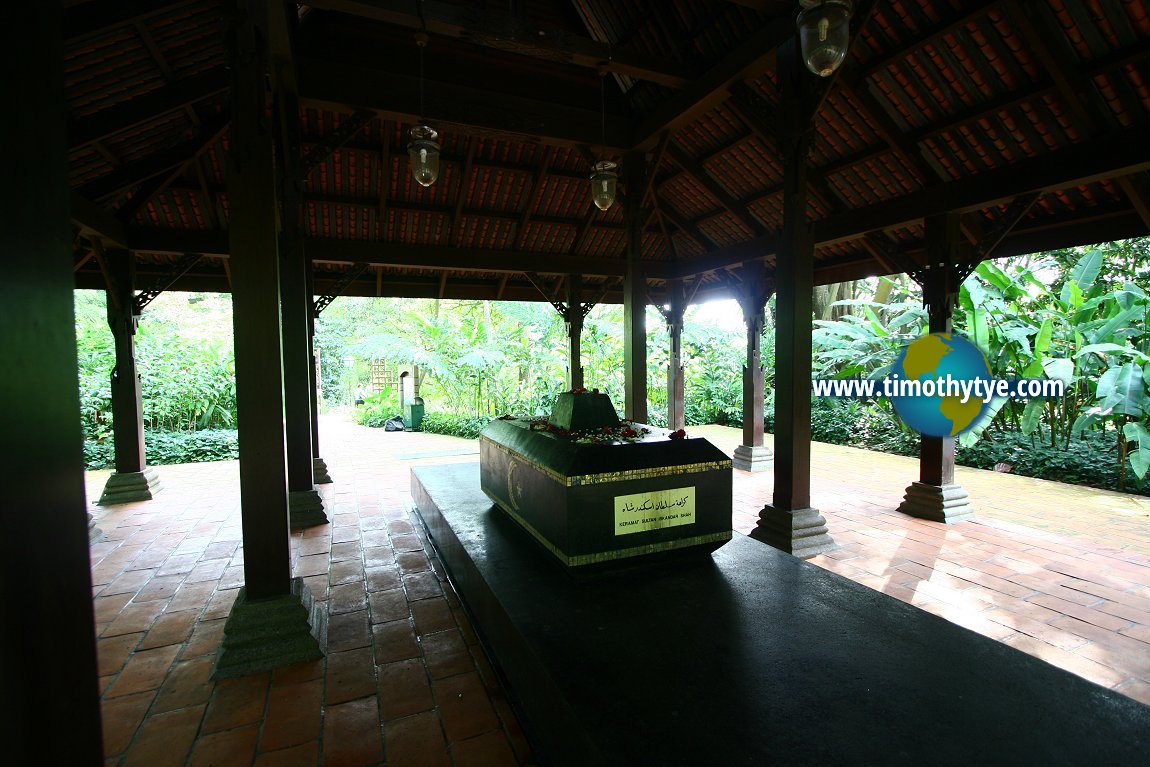 Keramat Iskandar Syah, Singapore (9 July 2006)
Keramat Iskandar Syah, Singapore (9 July 2006)
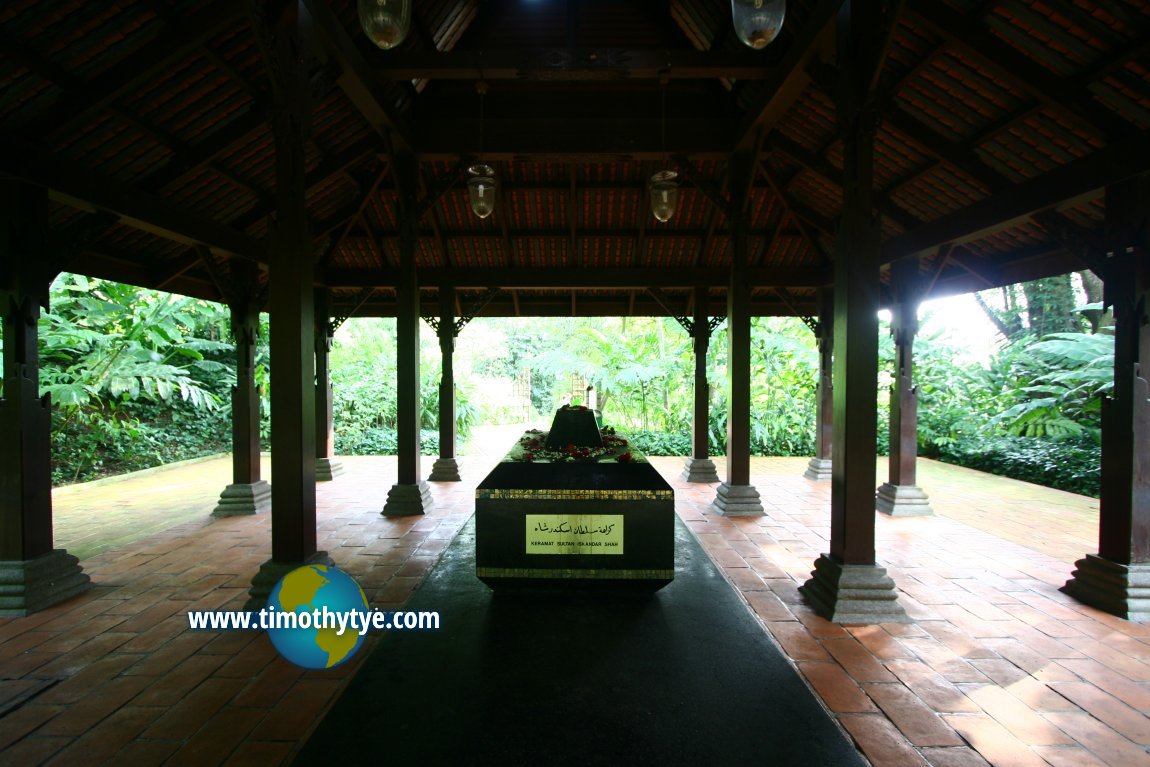 Keramat Iskandar Syah, Singapore (9 July 2006)
Keramat Iskandar Syah, Singapore (9 July 2006)
Malay chronicles state that the first King of Malays, Sri Tri Buana and his Chief Minister, Demang Lebar Daun were buried at Bukit Larangan, now known as Fort Canning. The grave called Keramat Iskandar Syah has been known as early as by 1822, a few years after the modern establishment of Singapore, and had been venerated by Muslims, Chinese and Hindus. Although the original structure has since disappeared, recent archaeological excavations unveiled 14th century artefacts a few metres north and east of it.
Malay Annals
According to Malay Annals, Sri Sultan (Raja) Mohammad Iskandar Shah, who was also known as Parameswara before his conversion to Islam, was the last of five kings from Majapahit royal blood. Iskandar Shah had moved to the Malay Peninsula and ruled over Malacca and Singapore in the 14th century. He is sometimes identified with Parameswara, the descendent of Sang Nila Utama. Sang Nila Utama, also known as Sri Tri Buana, is credited to have arrived at Temasek, as Singapore was called at that time. He saw a lion-like beast on the island, and renamed the island Singapura.
Iskandar Shah is said to have fled Singapore for Muar and then Malacca. There is no conclusive evidence whether his remains are buried in the Keramat Iskandar Syah. The grave is still being maintained by a Muslim family and their descendants who keep the burning of incense there.
Portuguese Records
Portuguese records, based on accounts of Alfonso d'Alburquerque, the Portuguese governor of Malacca, stated that the founder of Malacca was Parameswara, a runaway Javanese prince who fled Palembang for Temasek where he murdered and usurped the island's throne. However, he was forced to flee again again, when Thai forces invaded the island to avenge the murder of the ruler, their vassal.
Chinese records
Another account on Iskandar Shah came from Chinese sources. Ming dynasty tablets indicate that on 3 October 1405, Pai-li-mi-su-la, interpreted as Parameswara, paid homage to the Chinese Emperor. However, after five further visits over a span of two years, the Ming court was informed of his death on 5 October 1414 by his son, Mu-kan-sa-yu-ti-er-sha, interpreted as Megat Iskandar Shah.
Several Malay rulers called themselves Iskandar, claiming to have descended from Iskandar Zulkarnain, or Alexander the Great.However, only one, Iskandar Shah, was mentioned in the Malay Annals, as being the founder of Malacca. This ruler, however, is believed to have died and was buried in Malacca, not in Singapore. In all likelihood, it was Sri Tri Buana who was buried at Bukit Larangan, and not Iskandar Shah, blurring the claim that the grave is that of the latter's.
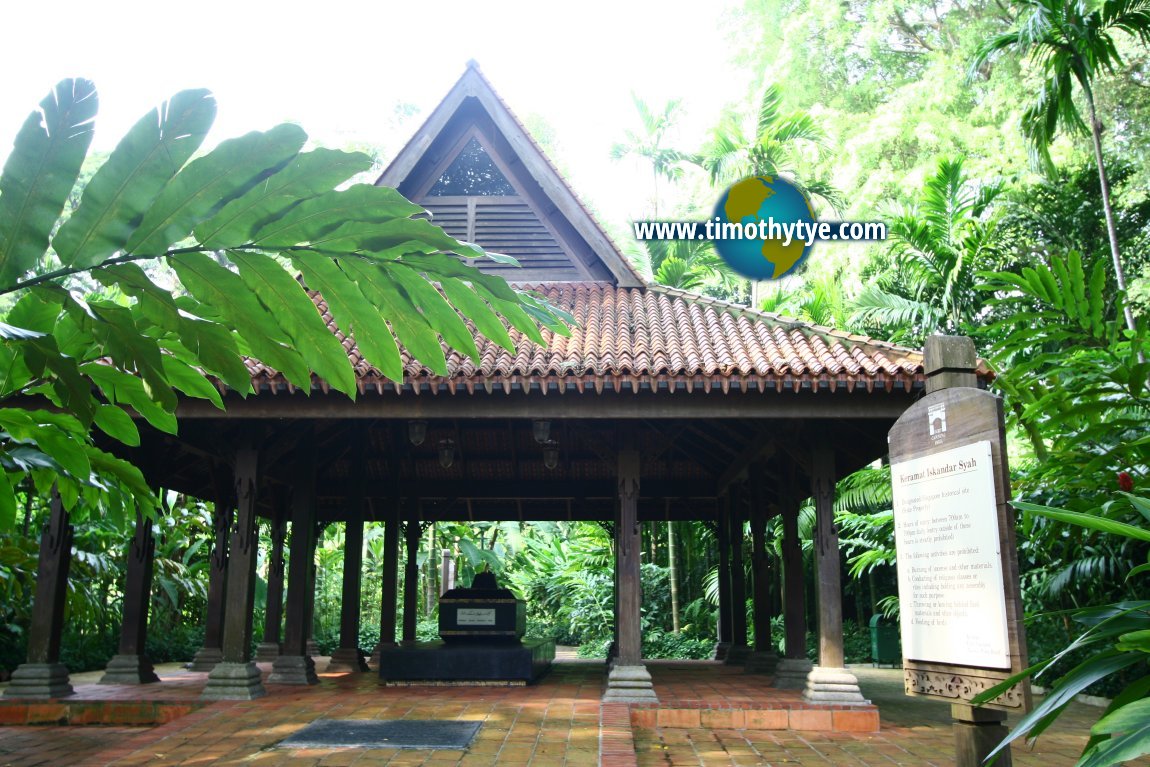 Keramat Iskandar Syah, Singapore (9 July 2006)
Keramat Iskandar Syah, Singapore (9 July 2006)
Keramat Iskandar Syah is  on the map of Fort Canning
on the map of Fort Canning
List of Muslim Shrines in Singapore; Discover Singapore Sights in Singapore
Sights in Singapore
 Latest updates on Penang Travel Tips
Latest updates on Penang Travel Tips
 Streets of Singapore and Map of Singapore Streets
Streets of Singapore and Map of Singapore Streets
 Singapore MRT and Map of Singapore MRT
Singapore MRT and Map of Singapore MRT
 Postal Districts of Singapore and Map of Singapore Postal Districts
Postal Districts of Singapore and Map of Singapore Postal Districts
 Planning Areas of Singapore and Map of Singapore Planning Areas
Planning Areas of Singapore and Map of Singapore Planning Areas
About this website

Dear visitor, thank you so much for reading this page. My name is Timothy Tye and my hobby is to find out about places, write about them and share the information with you on this website. I have been writing this site since 5 January 2003. Originally (from 2003 until 2009, the site was called AsiaExplorers. I changed the name to Penang Travel Tips in 2009, even though I describe more than just Penang but everywhere I go (I often need to tell people that "Penang Travel Tips" is not just information about Penang, but information written in Penang), especially places in Malaysia and Singapore, and in all the years since 2003, I have described over 20,000 places.
While I try my best to provide you information as accurate as I can get it to be, I do apologize for any errors and for outdated information which I am unaware. Nevertheless, I hope that what I have described here will be useful to you.
To get to know me better, do follow me on Facebook!
Copyright © 2003-2025 Timothy Tye. All Rights Reserved.
 Sights in Singapore
Sights in Singapore Latest updates on Penang Travel Tips
Latest updates on Penang Travel Tips Streets of Singapore and Map of Singapore Streets
Streets of Singapore and Map of Singapore Streets Singapore MRT and Map of Singapore MRT
Singapore MRT and Map of Singapore MRT Postal Districts of Singapore and Map of Singapore Postal Districts
Postal Districts of Singapore and Map of Singapore Postal Districts Planning Areas of Singapore and Map of Singapore Planning Areas
Planning Areas of Singapore and Map of Singapore Planning Areas
Copyright © 2003-2025 Timothy Tye. All Rights Reserved.

 Go Back
Go Back